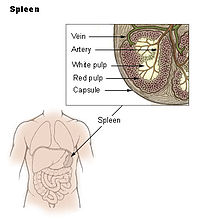
Photo from wikipedia
Background: The introduction of texture to the outer shell of breast implants was aimed at increasing tissue incorporation and reducing capsular contracture. It has also been shown that textured surfaces… Click to show full abstract
Background: The introduction of texture to the outer shell of breast implants was aimed at increasing tissue incorporation and reducing capsular contracture. It has also been shown that textured surfaces promote a higher growth of bacteria and are linked to the development of breast implant–associated anaplastic large cell lymphoma. Methods: The authors aimed to measure the surface area and surface roughness of 11 available implants. In addition, the authors aimed to subject these implant shells to an in vitro bacterial attachment assay with four bacterial pathogens (Staphylococcus epidermidis, S. aureus, Pseudomonas aeruginosa, and Ralstonia pickettii) and study the relationship among surface area, surface roughness, and bacterial growth. Results: Surface area measurement showed grouping of implants into high, intermediate, low, and minimal. Surface roughness showed a correlation with surface area. The in vitro assay showed a significant linear relationship between surface area and bacterial attachment/growth. The high surface area/roughness implant texture grew significantly more bacteria at 24 hours, whereas the minimal surface area/roughness implant textures grew significantly fewer bacteria of all types at 24 hours. For implants with intermediate and low surface areas, some species differences were observed, indicating possible affinity of specific bacterial species to surface morphology. Conclusions: Implant shells should be reclassified using surface area/roughness into four categories (high, intermediate, low, and minimal). This classification is superior to the use of descriptive terms such as macrotexture, microtexture, and nanotexture, which are not well correlated with objective measurement and/or functional outcomes.
Journal Title: Plastic and Reconstructive Surgery
Year Published: 2018
Link to full text (if available)
Share on Social Media: Sign Up to like & get
recommendations!